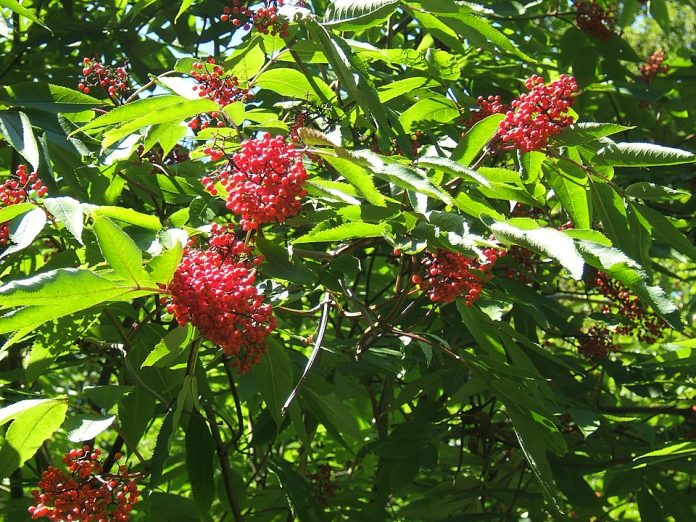
Featured Photo by MPF / CC BY 2.5
A field guide on how to identify and propagate Red Elderberry (Sambucus racemosa), a hardy shrub that is native to Europe.
How to Identify Red Elderberry (Sambucus racemosa)
Leaves
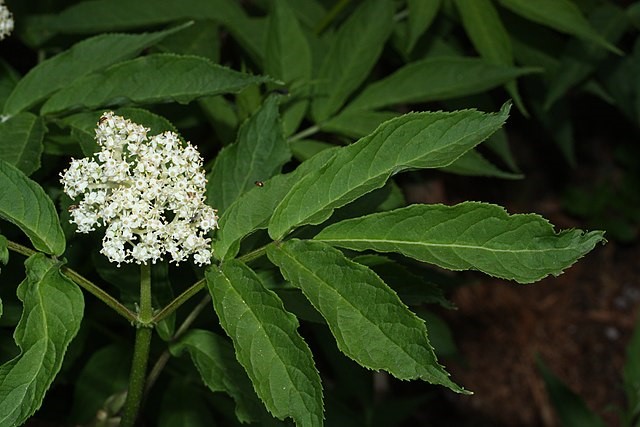
Red elderberry leaves are elliptical to lance-shaped, have wavy, serrulate margins, and grow on the stems in opposite arrangements.
Fruit
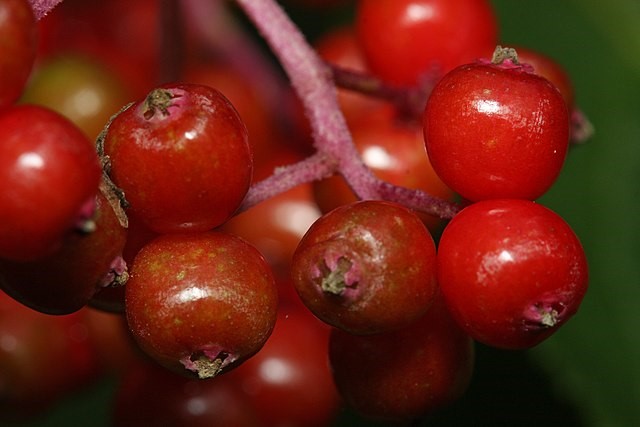
Red elderberry fruits are small, round berries that are bright red in color when ripe. They grow in clusters and have a tart, slightly sweet taste. The fruits are often used for making jams, jellies, and syrups, and are also eaten by birds and other wildlife.
Flower
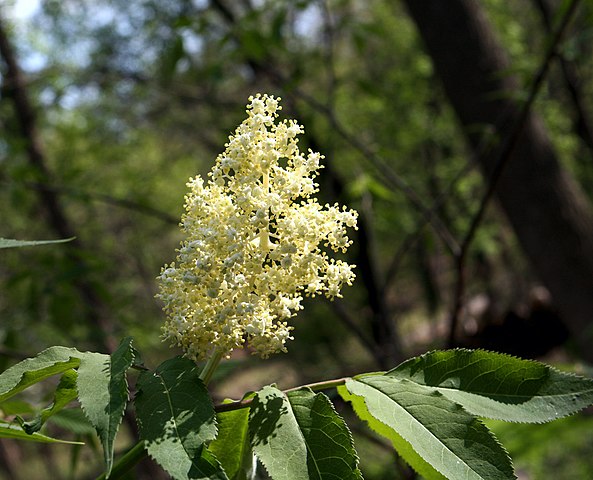
Red elderberry flowers are small, creamy-white, and grow in clusters called cymes. They have a distinct odor that can be quite strong and unpleasant.
Flowering Season
You can spot elderberry shrubs blooming from late spring to early summer.
Habitat
Red elderberry can be found in a variety of moist and open environments, including stream banks, swampy thickets, moist clearings and meadows, open forests, ditches, and disturbed areas, ranging from sea level to middle elevations.
Some other trees & understory plants that associate with red elderberry are:
- Trembling Aspen (Populus tremuloides)
- Sugar Maple (Acer saccharum)
- Alternate-leaf Dogwood (Cornus alternifolia)
Wildlife Value
Red elderberry fruits are consumed by numerous frugivorous birds such as blue grouse, band-tailed pigeons, and at least 50 passerine and 6 game bird species.
Mammals like bears, raccoons, and white-footed mice also eat the fruits, and browsing ungulates consume the foliage, bark, and buds.
Additionally, red elderberry and Mexican elderberry serve as hosts to the federally threatened valley elderberry longhorn beetle.
How to Propagate Red Elderberry (Sambucus racemosa),

Hardiness Zone: 2-7

Soil Type: Loam, sand.

Water: Normal.

Exposure: Full Sun to Part Shade.
You can propagate red elderberry with two effective methods:
- Stem Cuttings: It provides established trees faster, but is tricky, and will probably have a lower success rate.
- By Seed: The success rate is high but takes longer to get established saplings.
How to Propagate Red Elderberry (Sambucus racemosa) by Seed
If you have access to red elderberry bushes near you, you can harvest the seeds yourself.
If not, you can always order the seeds online at sheffields.
How to Harvest Seeds
There are 3 options to harvest the seeds from the fruits.
- The first option involves cutting open the fruits and extracting the seeds with tweezers, which is very time-consuming.
- The second option is to use a blender to blend the fruits, strain the mixture, remove the pulp, strain it again, and collect the small seeds.
- Simply freeze the fresh fruit, don’t even harvest them. Let them do part of the stratification this way.
If you choose option 1 or 2, it’s essential to let the seeds dry thoroughly to store them properly. For air drying, keep them in a cool, well-ventilated area away from direct sunlight.
Try to avoid storing the seeds for too long as they’ll lose their viability.
Sowing
For outdoor sowing, plant in the fall for sprouting in the following spring.
For indoor sowing, elderberry seeds require cold stratification which can be done as follows:
- Place seeds in a ziplock bag with damp sand and label them with the name and date.
- Store in the refrigerator for 60 days, then soak in room temperature water for 12 hours.
- Return to the ziplock bag and refrigerate for an additional 30 days.
- Once the stratification process is complete, plant the seeds under 1/4 inch of potting soil, keep them moist, and cover them with plastic wrap to maintain humidity.
When they germinate, remove the wrap, and try to water from underneath your pot, and let the water rise into the soil.
Personally, I do this to avoid damaging the tiny seedlings.
I also recommend placing them in a well-ventilated area to prevent any rot or mold from coming after your seedlings.
How to Propagate Red Elderberry (Sambucus racemosa) by Cuttings
A great method to propagate elderberry is by taking hardwood cuttings. The best time to do that is late fall or early spring when the shrub is still dormant.
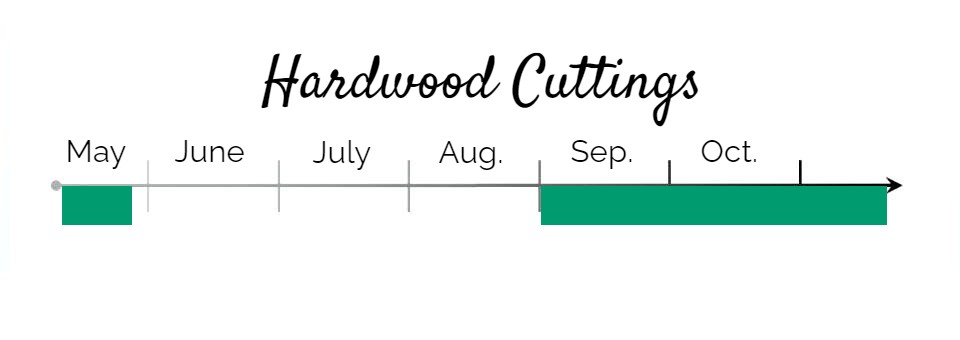
Very important: Choose a young, healthy plant to take cuttings from. Older shrubs are less vigorous and harder to root!
Step 1: Harvest the Cuttings
- Look for branches with new growth from the previous year or two.
- Cut below a node, ensuring the width is at least 1/4″ to 1/2″ each, and trim any forking branches.
- Cut the branch into 6-8 inch long cuttings with multiple pairs of nodes.
Step 2: Root the Cuttings
- Use a well-drained, well-aerated mix like peat moss with perlite.
- Place cuttings in indirect sunlight, ensuring the leaf nodes are facing the right direction.
- Keep the medium moist and well-ventilated to prevent rot.
- Elderberry cuttings root in about 3-4 weeks.
- Wait at least 8 weeks for the roots to establish before transplanting.
FAQ
A: Red elderberry berries can be poisonous if eaten raw, but they are safe to eat when cooked. Native Americans used the berries in recipes such as wine, jelly, and jam.
A: Red elderberry has dome-shaped clusters of white flowers branching off a main stem, while black elderberry has large clusters of flowers in wide, flat umbels originating from the same point on a stem without branching off.
A: Good question, the true red elderberries (Sambucus racemosa) are native to eastern North America. In BC, the variety of red elderberry is called pacific red elderberry (Sambucus racemosa subsp. racemosa).
A: Yes, but eating elderflowers or elderberries raw is generally not recommended due to their mild toxicity, which can cause stomach upset. Elderflowers are typically infused rather than eaten, and elderberries are cooked before use in recipes such as syrup, wine, or pontack sauce.
